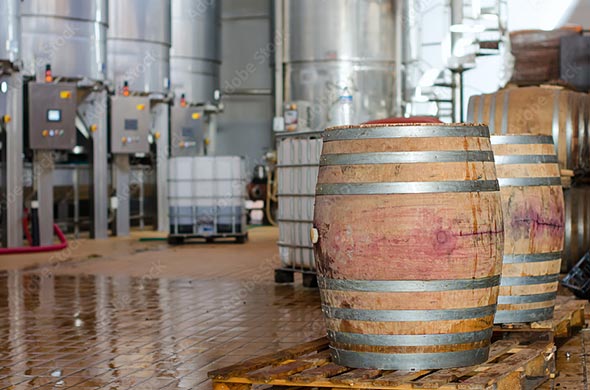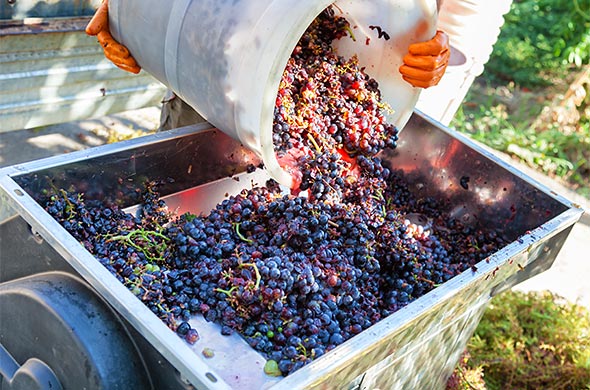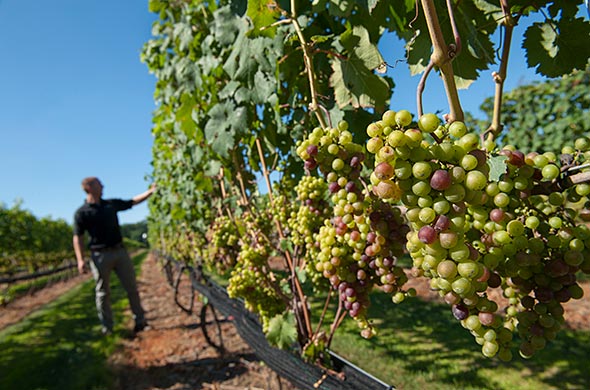
Wine production consumes large amounts of energy and generates a sizeable quantity of greenhouse gases. In winemaking, much of the power is consumed by refrigeration for cooling including fermentation, cold stabilization, and temperature maintenance during cold storage and aging. Many other electrical systems used in wineries contribute to the total energy consumption including processing equipment (e.g., grape crushers and destemmers), compressed air systems, bottling equipment, transfer pumps, wastewater treatment systems, heating, and lighting.
Crushing and Destemming
Grapes are generally harvested from early August through mid-October in New Jersey. Large stems are removed, and the grapes are fed into crushers. Wine crushing is a gentle process designed to extract the grape juice from the grape flesh and reduce the tannins and phenolic compounds from grape skin and from the taint of seeds. Timing is more critical for grape crushing as the fruit is fragile and the time taken between picking to crushing needs to be short to reduce spoilage and quality degradation. Receiving, destemming and crushing are characterized by high levels of manual activity for short periods of time. This may include manual dumping into hoppers in smaller wineries. Additional time is taken to clean the crushers after each batch and this manual washing is time consuming and labor intensive.
Crushers are used in short periods of time each year. Depending on the winery size and capacity and depending on the age of the crushers the wineries may assess and make their decision to make further investments for more energy efficient crushers.
Fermentation
The fermentation process uses yeast to convert grape sugars to alcohol and carbon dioxide. This process relies on the heating and cooling system for precise temperature control. Red wine fermentations are generally controlled between 75°F and 80°F, whereas white wine is fermented between 48°F and 60°F.
Stabilization and Refrigeration
Wine stabilization also requires energy consumption. The post-fermentation wine is stored and aged at low temperatures to prevent oxidation and other undesirable chemical reactions in the wine. White wine is generally stored at 40°F to 44 °F on average, whereas red wine is generally kept between 45°F and 70 °F. The refrigeration systems operate at their heaviest load during the crushing and primary fermentation period between August and November. Since storing and aging wine continues throughout the year, the refrigeration system operates year-round as needed, based on the size and the capacity of the winery. Refrigeration, compressed air, and process equipment energy consumption account for 68% to 84% of overall energy consumption in large and very large wineries, whereas the lighting and HVAC energy consumption is weighted more heavily in small/medium wineries accounting for about 36% of total energy consumption
Hot Water Usage
Wineries consume a considerable amount of heat for the process hot water usage. Hot water is used for tank heating, cleaning, and in some cases, heating wine after cold stabilization. In addition, some wineries use steam boilers. Reducing steam usage would help reducing energy consumption.
Fuel Consumption
Although fossil-based natural gas is a widely used fuel source, some wineries consume other fossil fuels such as liquid petroleum gas (LPG) and diesel fuel in their boilers or engines. Because emissions from fossil fuel consumption for electricity and heat generation is one of our main health and environmental concerns, reduction or elimination of fossil fuel consumption, will enable wineries to achieve lower energy usage related emissions (i.e., SOx, NOx, particulates, and CO.2). Technical assistance for energy efficiency can enable facilities to become more profitable through reduced energy bills, liability, and permit related expenditures. This will enhance the success of the wine making industry overall.
Recommended Literature for Winery Energy Efficiency
Guran Efficiency at Wineries (PDF)
Energy efficency in winemakeing industry: Challenges and Opportunities
California Energy Commission: Winery Water and Energy Savings (PDF)
Washington State University: Energy Efficiency in Wineries Fact Sheet (PDF)
Managing Energy Costs in Wineries (PDF)


